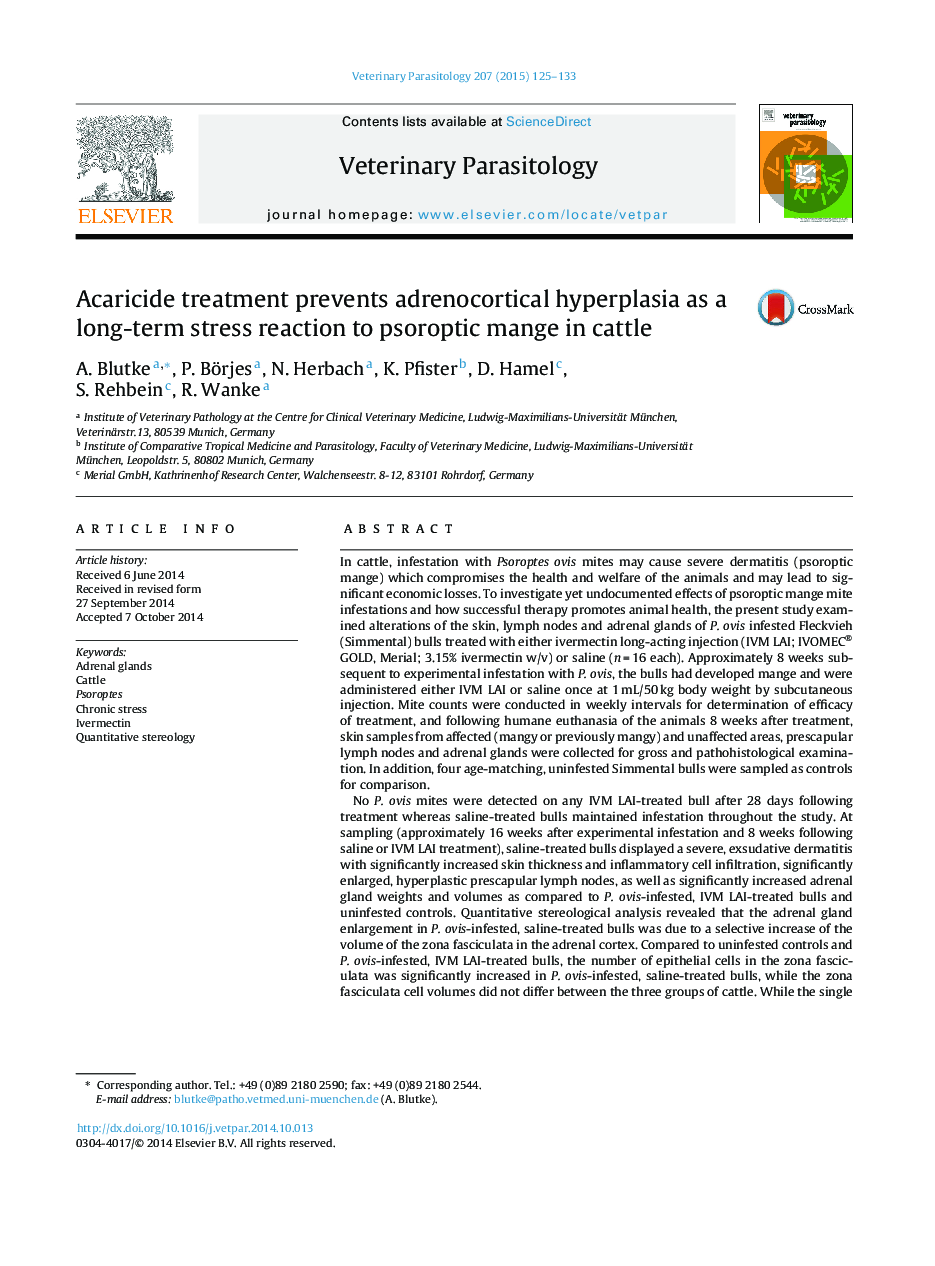| کد مقاله | کد نشریه | سال انتشار | مقاله انگلیسی | نسخه تمام متن |
|---|---|---|---|---|
| 5802877 | 1555677 | 2015 | 9 صفحه PDF | دانلود رایگان |
- We report effects of P. ovis infestation on skin, lymph node and adrenal morphology.
- Bovine psoroptic mange causes dermatitis, lymph node and adrenal gland enlargement.
- Psoroptic mange causes hyperplasia of the zona fasciculatain the adrenal cortex.
- This chronic stress reaction can be prevented by acaricidal treatment.
In cattle, infestation with Psoroptes ovis mites may cause severe dermatitis (psoroptic mange) which compromises the health and welfare of the animals and may lead to significant economic losses. To investigate yet undocumented effects of psoroptic mange mite infestations and how successful therapy promotes animal health, the present study examined alterations of the skin, lymph nodes and adrenal glands of P. ovis infested Fleckvieh (Simmental) bulls treated with either ivermectin long-acting injection (IVM LAI; IVOMEC® GOLD, Merial; 3.15% ivermectin w/v) or saline (n = 16 each). Approximately 8 weeks subsequent to experimental infestation with P. ovis, the bulls had developed mange and were administered either IVM LAI or saline once at 1 mL/50 kg body weight by subcutaneous injection. Mite counts were conducted in weekly intervals for determination of efficacy of treatment, and following humane euthanasia of the animals 8 weeks after treatment, skin samples from affected (mangy or previously mangy) and unaffected areas, prescapular lymph nodes and adrenal glands were collected for gross and pathohistological examination. In addition, four age-matching, uninfested Simmental bulls were sampled as controls for comparison.No P. ovis mites were detected on any IVM LAI-treated bull after 28 days following treatment whereas saline-treated bulls maintained infestation throughout the study. At sampling (approximately 16 weeks after experimental infestation and 8 weeks following saline or IVM LAI treatment), saline-treated bulls displayed a severe, exsudative dermatitis with significantly increased skin thickness and inflammatory cell infiltration, significantly enlarged, hyperplastic prescapular lymph nodes, as well as significantly increased adrenal gland weights and volumes as compared to P. ovis-infested, IVM LAI-treated bulls and uninfested controls. Quantitative stereological analysis revealed that the adrenal gland enlargement in P. ovis-infested, saline-treated bulls was due to a selective increase of the volume of the zona fasciculata in the adrenal cortex. Compared to uninfested controls and P. ovis-infested, IVM LAI-treated bulls, the number of epithelial cells in the zona fasciculata was significantly increased in P. ovis-infested, saline-treated bulls, while the zona fasciculata cell volumes did not differ between the three groups of cattle. While the single point determination of serum cortisol concentrations did not reveal significant differences between the three groups of cattle at tissue sampling, the hyperplastic growth of the adrenal cortex in the P. ovis-infested, saline-treated bulls provides morphologic evidence that a chronic stress reaction is one consequence of mange mite infestations that can be prevented by efficacious acaricidal treatment.
Journal: Veterinary Parasitology - Volume 207, Issues 1â2, 15 January 2015, Pages 125-133
